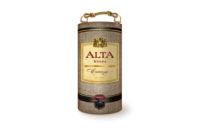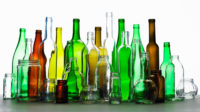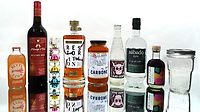Glass packaging’s naturally premium appeal

In connection with closures and secondary labels, customized glass bottles can allow for unifi ed brand messaging, says Owens-Illinois’ Raul Paredes. (Image courtesy of Owens-Illinois)

Verallia North America released a cobalt blue bottle last year that is being used by one of the largest beer companies. (Image courtesy of Saint-Gobain Containers)


Whether it’s the growth of the wine, spirits and craft beer markets or the popularity of natural beverages, glass packaging manufacturers note that these trends are having a positive effect on this primary packaging material.
“We’re seeing emerging categories such as energy drinks explore glass packaging,” says Cedric Washington, senior marketing manager of food and non-alcoholic beverages for Owens-Illinois (O-I), Perrysburg, Ohio. “There’s also the ongoing growth of the natural, health[y] beverage categories such as teas and juices.”
Consumers also have shown interest in craft-style beverages, such as craft spirits and beer, and many of those brewers and distillers have selected glass packaging for their brands, says Mark Repko, director of marketing development for Verallia North America, a subsidiary of Saint-Gobain North America, Valley Forge, Pa.
Premium reasoning
Although brand owners have their own motivations for selecting a particular packaging container, Repko says a popular reason to choose glass — particularly within the alcohol beverage categories — is its premium association.
“Consumers continue to demonstrate a move to and preference for premium brands within each product category,” he says. “Glass conveys a high-end look and feel, making it the ideal choice for premium brands.”
Repko adds that consumers generally prefer glass packaging. Citing a Newton Market Research survey, he says 73 percent of consumers surveyed reported that they believe glass packaging has the highest quality of any type of container. Additional findings from survey participants include 78 percent stating that they think glass is the best at maintaining purity and 82 percent agreeing that they think glass is the healthiest way to preserve the products that they buy, Repko says.
“Overall, consumers have expressed their preference for glass, so beverage manufacturers are demonstrating that they are listening by offering their products in glass,” he says.
More specifically, glass packaging received positive responses from beer, wine and spirits drinkers in the Newton Marketing Research study, Repko explains. Ninety-one percent of beer, wine and spirits drinkers said that glass is the best packaging for preserving flavor and taste, Repko says, citing the study.
“By an overwhelming margin, wine-makers and wine drinkers prefer glass packaging to preserve the quality and flavor of a vintage if it’s tucked away in a wine cellar for many years,” Repko says. The study also found that 84 percent of the non-alcohol beverage consumers surveyed reported believing that glass is the best packaging material for preserving flavor and taste, he adds.
Conducting its own omnibus survey in 2011, O-I found that 85 percent of Americans think products taste better in glass, Washington says. Because glass is flavorless and odorless, it can protect product freshness for the health and wellness-focused companies, he adds.
“Health and wellness continues to be a focus for consumers,” Washington says. “We’ve seen beverage brands in the natural, health space such as teas, juices and iced coffees continue to seek out glass packaging for their products because it is natural and inert [and] made from four simple ingredients: sand, limestone, soda ash and recycled glass (cullet).”
Given that it contains only four ingredients and is 100-percent endlessly recyclable, glass packaging can be a natural choice for companies interested in sustainability, Washington notes.
“Many companies are evaluating their processes to see how they can make changes to lessen their impact on the earth,” he says. “We have lots of customers who ask about lightweighting not only to reduce their transportation costs but also to save on energy usage overall.”
Citing a study by EcoFocus, Lynn Bragg, president of the Glass Packaging Institute, Alexandria, Va., says sustainability is important to a number of wine consumers.
In the EcoFocus study, which polled more than 2,100 wine buyers in the age category from 21 to 65, it linked consumers’ sustainability values with wine, Bragg says.
She adds that the study also found that both frequent and premium wine consumers associated sustainability with higher quality and associated eco-friendly features with higher quality. Because of these trends, Bragg says glass manufacturers are focusing on innovation in lightweighting and batch mixes.
In response to customer requests, Verallia’s wine team developed its Eco Series bottles, which average 15 percent less weight than bottles with comparable standard designs, Verallia’s Repko says.
Although glass packaging might be known for its premium and natural characteristics, sometimes its design abilities can be overlooked, experts note.
“Glass has an often-overlooked innovative nature and can be designed, molded and shaped in many unique ways,” says Raul Paredes, O-I’s manager of product development and innovation.
He adds that O-I offers proprietary innovation solutions and can mold glass shapes and sizes as well as enhance designs with integrated decoration techniques.
“In-mold glass embossing, debossing and texturing are often used together with bottle profiles, as well as secondary labels and closures, to create a unified brand message,” Paredes says. “By doing so, glass can integrate the brand’s tenets directly into the structural package, strongly reinforcing the brand’s equity and creating a better connection between the beverage or the product and the package.”
The company utilized internal embossing, a glass package with geometric embossing inside the container, for Miller Lite’s Vortex bottle. “Our process allows us to create dynamic patterns and designs to add to the aesthetic nature of the container, and because this geometry is internal to the bottle, it does not interfere with down-stream labeling, secondary packaging or handling,” he adds.
In addition to modular molds, O-I also has launched Black Glass, a new glass material formulation that provides high levels of ultraviolet protection to the liquid it carries, Paredes says.
The use of customized bottles and different glass colors is gaining in popularity, Verallia’s Repko says. Last year, the company launched a cobalt blue bottle, which is being used by one of the largest beer companies, he says.
For the wine category, Verallia recently introduced new colors that typically would be reserved for the European market and announced its new production capability, FlexRun Service, Repko adds.
“The first of its kind in the North American wine market, this service provides any winery, large or small, increased flexibility to run specialty bottles with limited investment,” he says. “Whether adding a customized embossment to a stock bottle or creating an entirely new bottle design, it has never been easier to create shelf impact with a wine brand through custom glass design.”
The company’s design teams also are receiving increased requests for customized bottles with logos, personalized markings or unique company-name fonts and scripts for spirit brands, Repko adds.
“Decoration options for glass containers provide a great platform for brand enhancement, whether it’s on the label or decoration directly blown into the glass bottle during the manufacturing process,” he says.
Repko anticipates that the demand for unique, personalized bottles will continue to grow and will be a key part of glass packaging’s future.
“As demand for innovative design continues to grow, the company and the industry anticipate a shift from ‘standard’ or stock-type containers to more ‘branded,’ specific shapes and colors,” he says.
Looking for a reprint of this article?
From high-res PDFs to custom plaques, order your copy today!









